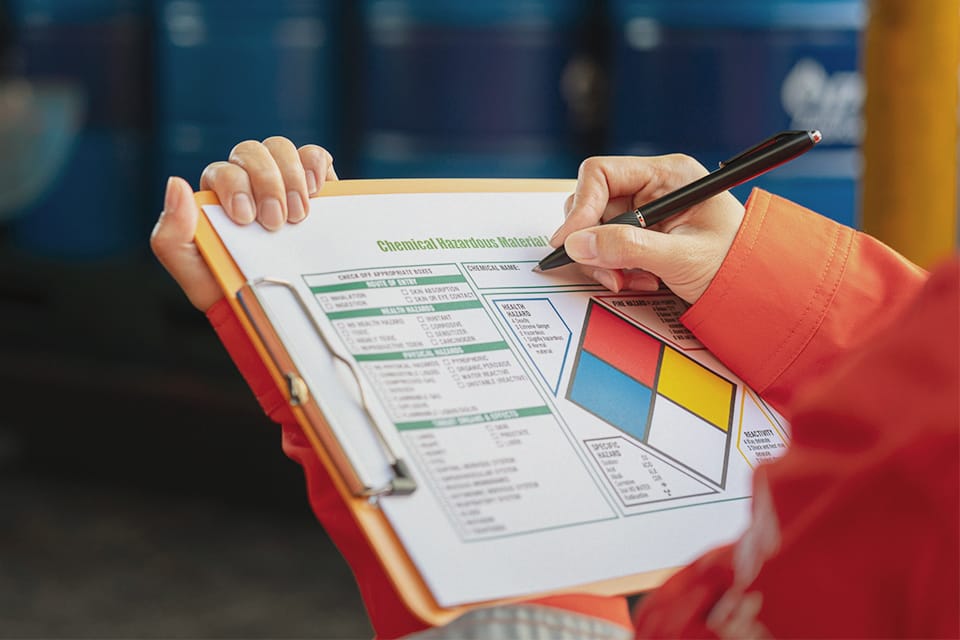
OSHA Logs Are Due: Don’t Make These 5 Costly Mistakes | Risk Matrix Episode 123
THE RISK MATRIX Cutting-edge podcast on occupational safety and risk management. Hosted by industry titans: JAMES JUNKIN, MS, CSP, MSP,…

Hazard communication is critical to safety in any environment involving dangerous substances, where workers can face various risks. As such, hiring clients must establish the proper communication policies and procedures to safeguard workers and prevent incidents.
This article briefly discusses the hazard communication concept and six essential steps for its implementation and execution.
“Hazard communication” is a set of procedures companies execute to safeguard employees from hazardous substances that endanger their well-being. These processes are critical for properly handling, processing, or storing chemical products.
In the United States, OSHA’s Hazard Communications Standards stipulate that labels, safety data sheets, and employee communications, including training and information, must follow specific standards. These preventive measures can enhance occupational safety and decrease work-related injuries.
The employer handles ensuring a secure working environment. This includes adherence to 29 CFR 1910.1200 (h), the hazard communication standard (HCS) established by OSHA, and supplying sufficient training to employees about the safe handling of hazardous materials. The company is also responsible for ensuring contractors receive the same training and information.
Before starting any project, however, companies should perform a hazard assessment and appoint a trained and experienced supervisor to oversee tasks, ensuring workers follow all safety precautions.
Learning OSHA’s hazard communication standards and understanding how they affect you and your workforce are essential first steps for employers who manage hazardous substances. Otherwise, safety managers cannot find what is necessary to support compliance.
Also critical is assigning suitable personnel to oversee the plan’s management, as developing the program once and never revisiting it will not suffice in an ever-changing work environment. The plan’s manager must perform ongoing reviews and adjust the terms as necessary.
Safety data sheets (SDS) feature comprehensive information about hazardous materials in work environments. They detail each substance’s physical and health hazards, essential protective measures, and related pertinent details.
Companies use these documents to develop proactive workplace safety policies and training programs about effectively managing chemical hazards and informing employees about potential dangers.
U.S. companies should also take note of OSHA’s updated requirements updates for what must appear on safety data sheets. The new standard incorporates a 16-section format needed in every safety data sheet, which is much more comprehensive than the original requirements.
More specifically, these new requirements include (but are not limited to) the following added sections:
In addition, OSHA recommends that companies design a HazCom advisor to oversee the upkeep of safety data sheets and collaborate with chemical manufacturers on issuing updated information.
Employers must ensure that all containers with hazardous compounds and substances are appropriately labeled. These labels must be legible and clearly displayed to enable workers to identify them quickly.
OSHA outlines six attributes that are integral to all labels:
Developing and upholding a written hazard communication program is another critical step in following the OSHA Hazard Communication Standard. This document should include a detailed explanation of how work sites will implement the standards, aiding in coordinating and systematizing the program.
When developing these HazCom blueprints, companies should ensure that the following details are incorporated:
With a few exceptions, these requirements are non-negotiable for most employers who handle substances in the workplace.
Companies must supply worker training on accessing and utilizing SDSs and label information and all other facets of your HCS program, including but not limited to:
OSHA’s HCS requirement also stipulates that companies must provide training in a manner and language suitable for all workers, and they must review the material periodically to ensure retention. This process establishes the training language(s) and how employers conduct it.
A critical (but sometimes ignored) aspect is periodic worker retraining, which should occur for everyone when:
Although federal OSHA does not mandate periodic training for employees, it is advisable to implement regular exercise as a standardized procedure to aid in the retention of vital HCS information by staff.
Lastly, the hazard communication program must remain up-to-date and pertinent to everyone in the company, and reviewing and revising the program periodically to account for workplace changes is necessary to carry this out.
Those changes might include the following:
By viewing the HCS program as a living, breathing entity instead of a one-time mandate, companies can mitigate the risk of committing severe violations as their situations change.
It also shows workers that management proactively prioritizes their safety, contributing to a more robust safety culture and enhancing the organization’s overall sustainability.
Creating and implementing a sound hazard communication plan is crucial to promoting workplace safety by laying out a process for identifying, handling, and disposing dangerous substances.
However, an effective plan alone isn’t enough to maximize worker safety. Companies must also integrate a process safety management solution that offers the chemical training necessary to support safety standards and create a culture of continuous safety improvement.
Consider partnering with us to tailor a solution to your hazard communication plan and protect your workers from the risks of handling dangerous substances.
Contact us today to learn more.


THE RISK MATRIX Cutting-edge podcast on occupational safety and risk management. Hosted by industry titans: JAMES JUNKIN, MS, CSP, MSP,…

THE RISK MATRIX Cutting-edge podcast on occupational safety and risk management. Hosted by industry titans: JAMES JUNKIN, MS, CSP, MSP,…
We’ll send you practical and insightful supply chain risk management info that can benefit your business. Plus, important company updates that keep you in the loop.
